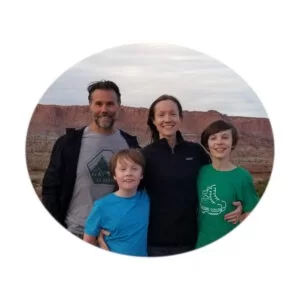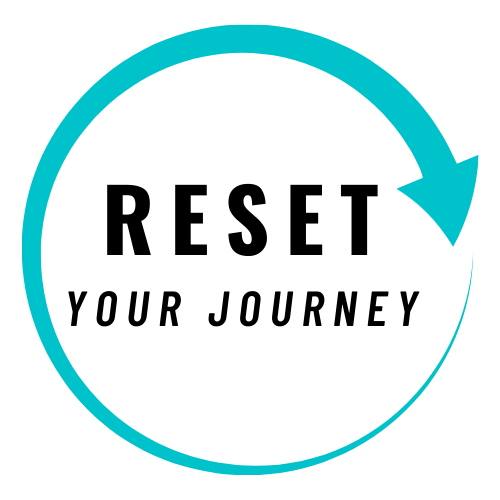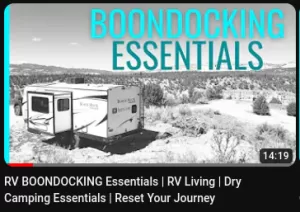Last Updated on 05/25/2024 by Glynn Willard
Water For Your RV
When the water runs out, the party’s over!
Your first concern when boondocking should be your water management rather than electricity needs.
We can all get by fairly well in the absence of electricity, but not water.
So how much water do you need in your freshwater tank for boondocking and where do you find a water source?
How Much Water Do You Need When Boondocking?
The amount of water necessary when boondocking is a very subjective statement. We all have different needs and a different rate of water usage.
But I can tell you what we narrowed down after two years of boondocking on public lands most of the time.
We were conservative with bathing, cleaning, and cooking. But we drank as much water as we wanted. We drink a lot of water.
Our family consists of myself, my wife, a ten-year-old old, and a thirteen-year-old to put things into perspective.
Over time, we averaged 3 gallons of water per person, per day. So simply put, we averaged 12 gallons a day when dry camping.
Your habits and needs will differ. The only way to know for sure is to quantify your usage in the beginning and refine it as you go.
A great way is to plan a short 2-3 day trip close to home (or stay in your driveway) on a full tank.
Figure out what’s left in the fresh tank when you’re done.
If your fresh water gauge is inaccurate (like most), lengthen each trip boondocking until you run out.
If your water consumption gets you to day 5, you have your answer.
Boondocking Watertank
Your fresh water tank in your RV is your main source (obviously).
Keep in mind, that if you have a tank-based water heater, you can pull additional water into your storage.
Most heaters are 5-10 gallons.
Newer RVs tend to have instant water heaters, eliminating the additional storage.
I suggest keeping several Jerry cans of water or a water bladder in your tow vehicle (or towed vehicle).
You never know when you’ll need a few extra gallons of fresh water.
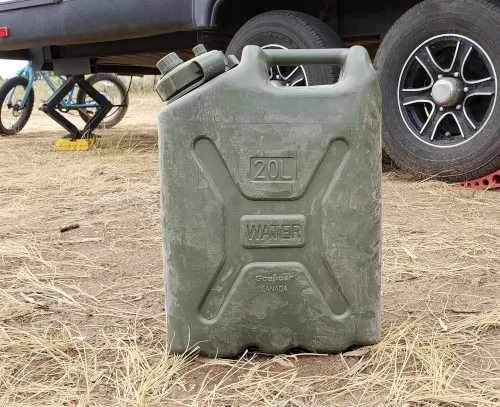
Make sure you cycle your external storage sources. We always maintained three 5-gallon Jerry cans in the mix.
Come up with a system that works for you.
Between our 80 gallon fresh water tank, 10 gallon heater and 15 gallons in Jerry cans, we could make it ten days.
Again, keep in mind, there are four of us and we took Navy showers every third day.
Boondocking Water Supply
How Do You Find Water When Boondocking? The ease of finding water is dependent on your geographic location.
Water is easy to find in the northwest. Water is far more difficult to find in the southwest.
In the east, it can also be difficult to find potable water since there’s so little boondocking.
Under those circumstances, Harvest Hosts, Boondockers Welcome, and RV parks are our go-to.
Our number one way to find water was through our apps, which I discuss below.
Our number two way of finding water was to ask others boondocking nearby.
The majority of boondockers are usually local, so they know the area.
They’re not all willing to share their water fill source, so be friendly and move on if not.
Where To Find Water When Boondocking
Here are a few of our hacks for finding water for boondocking.
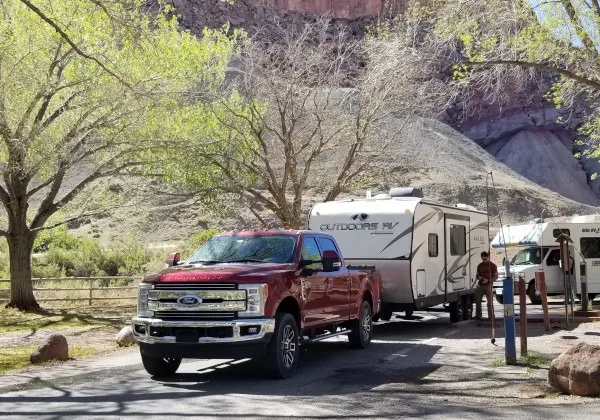
We’ve found water in the following locations (in no particular order):
- Campgrounds
- Rest areas that are RV friendly.
- National Parks
- Truck stops. You usually have to ask.
- Public dump stations with a potable water faucet far from the sewage area.
- Ma and Pa laundromats.
- Boondocker’s Welcome
- One to five gallons at a time from a grocery store (expensive).
- Gas stations (on occasion)
- If you have the equipment, fresh, fast-moving streams at higher elevations.
We always tried to find water near a dump station, so we could dump black tank and grey tank before refilling our freshwater.
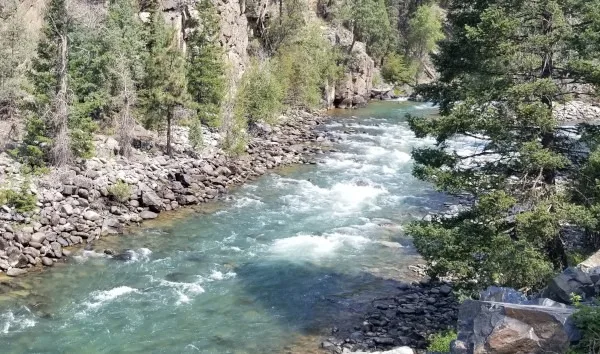
You will likely never need to look beyond the above suggestions for good places to find potable water.
Should You Buy Your Water From A Campground?
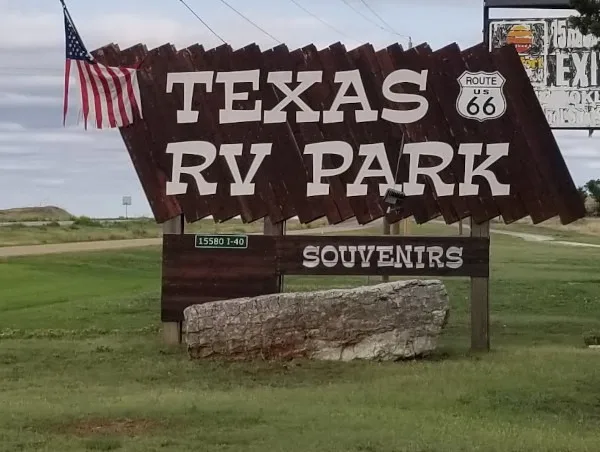
I’ve always found that buying water from a campground is one of the safest ways to acquire water when boondocking.
It’s a good idea to call first to ask if water is available to buy.
Some campgrounds charge unreasonably high water prices to minimize their traffic.
We’ve come across a lot of boondockers who book a campground every 7-10th day to dump their tanks, refresh their water, and take a long shower.
We’re guilty! Sometimes I would find an RV park that charged $20 for water, but their nightly rate was $30.
That’s a no-brainer… stay the night.
This was usually the case with state parks.
We’ve come across several and found that being friendly earned us free water. I suppose that’s universal karma for just being nice.
So, yes a campground can be a great option to find water for boondocking.
Best Aps For Finding Water Boondocking
We use several apps to find boondocking water. Here are the reputable ones currently available:
- Freeroam.app
- iOverlander
- The Dyrt (not free)
- Campendium
We rely exclusively on iOverlander and Freeroam.app.
Why? They’re both reliable, easy to use, and free.
Download those two and you probably will not need any other apps for finding water.
Is Water At Dump Stations Potable?
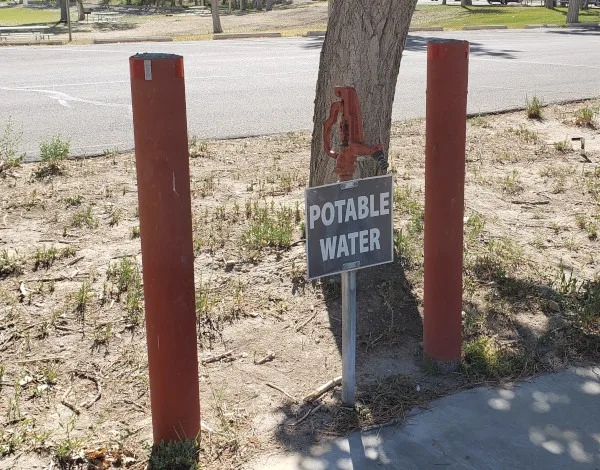
Is the water at dump stations safe to drink? If the blue or green faucet for potable water is not accessible while dumping your tanks, it is probably safe.
If it’s right next to the sewage area, be very cautious!
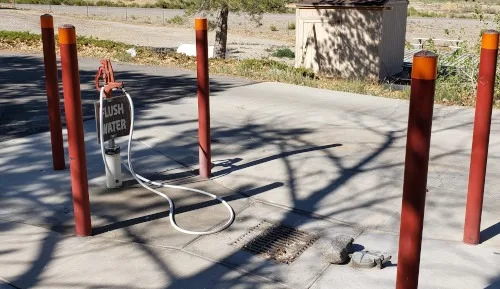
It’s way too easy for someone to accidentally (or lazily) use the potable source to rinse their sewer hoses and clean their holding tanks.
It’s just not worth the risk. A whole family with diarrhea while boondocking in a National Forest is not only dangerous, but it’s no fun!
We sadly know from experience.
Filling RV Water Tank While Boondocking
If you’re going to make a habit of bringing water to your rig while boondocking, invest in a small DC water pump.
You’ll need a water transfer pump if you’re using a bladder as an external source.
If you’re Jerry can has an attachable spout and your freshwater inlet is gravity-fed, that’s all you’ll need.
When our tank would get low, we would just start filling our water bottles and cooking water from the Jerry cans.
That way we reserved the water in the main tank for showers and washing dishes.
Boondocking Water Filter
For the sake of flavor, we always ran any water going into any of the tanks through a two phase filter.
Yes, the picture is an affiliate link, but it worked so well for us, there was no need to spend any additional money.
The filter system resided right next to our fresh water hoses. That way it was quick and easy. And no excuses.
It will also aid in maintaining a clean fresh water tank. You still have to sanitize it at a minimum every six months.
Rather than investing in a special filter that eliminates harmful pathogens, we only took water from trusted sources.
An inline UV water filter or reverse osmosis will have to be installed in your rig and require an electrical current. We didn’t find it necessary.
Not Sure What You Need For Your RV?
Sharing Water
If you have plenty of water while boondocking and you notice someone who might be in need, kindly ask them.
Use your judgment. Sometimes, it’s obvious. We encountered an individual with a dog that appeared really thirsty.
He was giving his dog small amounts at a time and sipping what he had. I simply asked, “How are you on water?”
He said, “I’m almost out and I don’t leave until tomorrow.” For him to leave, required packing up his whole camp since he was in a home-made truck camper.
I offered a couple of gallons and he lit up! The first thing he did was fill his dog’s bowl.
Take notice of these things and share if you have excess.
You don’t know when you’ll need to be on the receiving end of such kindness.
Wrapping Up How Much Water For Boondocking
We love to boondock almost as much as we like to have plenty of water!
There are a lot of ways to find and acquire water when boondocking. Apps are the best way to start.
Our favorite places to get fresh water for boondocking are national parks. They always have clean water.
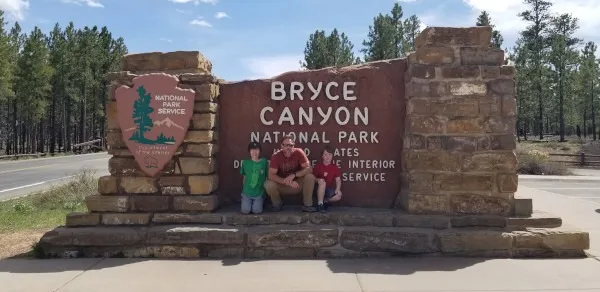
It will take you a few runs before you figure out just how much water you need when boondocking.
But once you have an idea and implement good water conservation habits, it reduces the anxiety of finding water when boondocking.
Happy boondocking!
Meet the author.
We appreciate any help in bringing you great content. Donate or buy us a coffee on our Ko-Fi site. Or subscribe to our YouTube Channel.
Thank you so much for being here!
